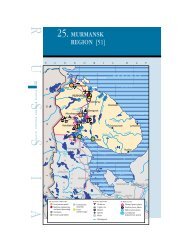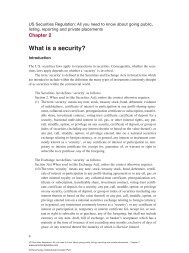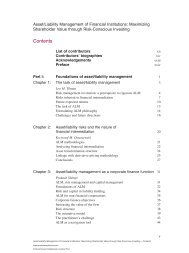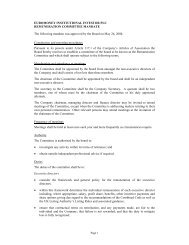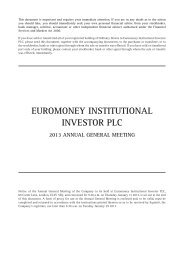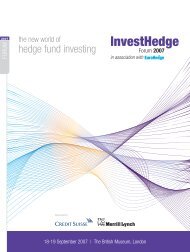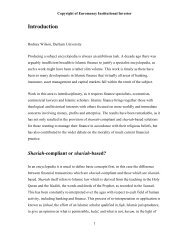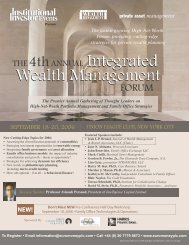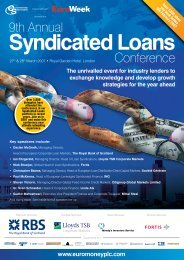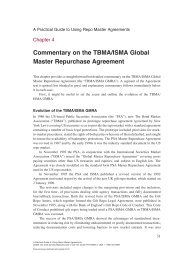Annual Report & Accounts 2012 - Euromoney Institutional Investor ...
Annual Report & Accounts 2012 - Euromoney Institutional Investor ...
Annual Report & Accounts 2012 - Euromoney Institutional Investor ...
You also want an ePaper? Increase the reach of your titles
YUMPU automatically turns print PDFs into web optimized ePapers that Google loves.
<strong>Euromoney</strong> <strong>Institutional</strong> <strong>Investor</strong> PLC <strong>Annual</strong> <strong>Report</strong> and <strong>Accounts</strong> <strong>2012</strong><br />
www.euromoneyplc.com<br />
Notes to the Consolidated<br />
Financial Statements continued<br />
1 Accounting policies continued<br />
Foreign currencies<br />
Functional and presentation currency<br />
The functional and presentation currency of <strong>Euromoney</strong> <strong>Institutional</strong><br />
<strong>Investor</strong> PLC and its UK subsidiaries other than Fantfoot Limited is sterling.<br />
The functional currency of subsidiaries and associates is the currency of<br />
the primary economic environment in which they operate.<br />
Transactions and balances<br />
Transactions in foreign currencies are recorded at the rate of exchange<br />
ruling at the date of the transaction. Monetary assets and liabilities<br />
denominated in foreign currencies are translated into sterling at the rates<br />
ruling at the balance sheet date.<br />
Gains and losses arising on foreign currency borrowings and derivative<br />
instruments, to the extent that they are used to provide a hedge against<br />
the group’s equity investments in overseas undertakings, are taken to<br />
equity together with the exchange difference arising on the net investment<br />
in those undertakings. All other exchange differences are taken to the<br />
Income Statement.<br />
Group companies<br />
The Income Statements of overseas operations are translated into sterling<br />
at the weighted average exchange rates for the year and their balance<br />
sheets are translated into sterling at the exchange rates ruling at the<br />
balance sheet date. All exchange differences arising on consolidation are<br />
taken to equity. In the event of the disposal of an operation, the related<br />
cumulative translation differences are recognised in the Income Statement<br />
in the period of disposal.<br />
Property, plant and equipment<br />
Property, plant and equipment are stated at cost less accumulated<br />
depreciation and any recognised impairment loss.<br />
Depreciation of property, plant and equipment is provided on a straightline<br />
basis over their expected useful lives at the following rates per year:<br />
Freehold land<br />
do not depreciate<br />
Freehold buildings 2%<br />
Long-term leasehold premises over term of lease<br />
Short-term leasehold premises over term of lease<br />
Office equipment 11% – 33%<br />
Motor vehicles 20%<br />
Intangible assets<br />
Goodwill<br />
Goodwill represents the excess of the fair value of purchase consideration<br />
over the net fair value of identifiable assets and liabilities acquired.<br />
Goodwill is recognised as an asset at cost and subsequently measured at<br />
cost less accumulated impairment. For the purposes of impairment testing,<br />
goodwill is allocated to those cash generating units that have benefited<br />
from the acquisition. Assets are grouped at the lowest level for which<br />
there are separately identifiable cash flows. The carrying value of goodwill<br />
is reviewed for impairment at least annually or where there is an indication<br />
that goodwill may be impaired. If the recoverable amount of the cash<br />
generating unit is less than its carrying amount, then the impairment loss<br />
is allocated first to reduce the carrying amount of the goodwill allocated<br />
to the unit and then to the other assets of the unit on a pro-rata basis. Any<br />
impairment is recognised immediately in the Income Statement and may<br />
not subsequently be reversed. On disposal of a subsidiary undertaking, the<br />
attributable amount of goodwill is included in the determination of the<br />
profit and loss on disposal.<br />
Goodwill arising on foreign subsidiary investments held in the consolidated<br />
balance sheet are retranslated into sterling at the applicable period end<br />
exchange rates. Any exchange differences arising are taken directly to<br />
equity as part of the retranslation of the net assets of the subsidiary.<br />
Goodwill arising on acquisitions before the date of transition to IFRS has<br />
been retained at the previous UK GAAP amounts having been tested for<br />
impairment at that date. Goodwill written off to reserves under UK GAAP<br />
before October 1 1998 has not been reinstated and is not included in<br />
determining any subsequent profit or loss on disposal.<br />
Internally-generated intangible assets<br />
An internally-generated intangible asset arising from the group’s software<br />
and systems development is recognised only if all of the following<br />
conditions are met:<br />
● An asset is created that can be identified (such as software or a<br />
website);<br />
● It is probable that the asset created will generate future economic<br />
benefits; and<br />
● The development cost of the asset can be measured reliably.<br />
Internally-generated intangible assets are stated at cost and amortised on<br />
a straight-line basis over the useful lives. Where no internally-generated<br />
intangible asset can be recognised, development expenditure is recognised<br />
as an expense in the period in which it is incurred.<br />
64






